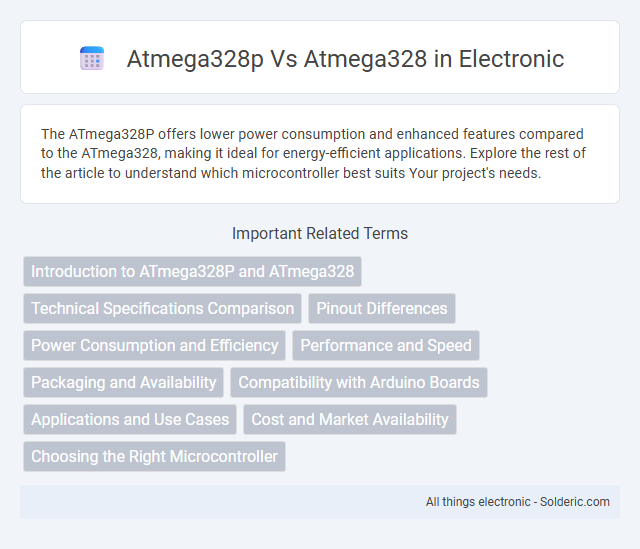The ATmega328P offers lower power consumption and enhanced features compared to the ATmega328, making it ideal for energy-efficient applications. Explore the rest of the article to understand which microcontroller best suits Your project's needs.
Comparison Table
| Feature | ATmega328P | ATmega328 |
|---|---|---|
| Core | 8-bit AVR | 8-bit AVR |
| Operating Voltage | 1.8V - 5.5V | 2.7V - 5.5V |
| Max Clock Speed | 20 MHz | 20 MHz |
| Program Memory (Flash) | 32 KB | 32 KB |
| SRAM | 2 KB | 2 KB |
| EEPROM | 1 KB | 1 KB |
| Package Options | 28-pin PDIP, TQFP, QFN | 28-pin PDIP, TQFP |
| Power Consumption | Lower, optimized for power saving | Higher compared to ATmega328P |
| Improvements | Enhanced power efficiency, better Brown-out Detection | Original version, no power optimization |
| Typical Applications | Battery-powered devices, low-power projects | General embedded systems |
Introduction to ATmega328P and ATmega328
The ATmega328P is an enhanced version of the ATmega328 microcontroller, both widely used in embedded systems and Arduino projects. The "P" in ATmega328P stands for "PicoPower," indicating improved power efficiency and lower power consumption compared to the original ATmega328. Your choice between these microcontrollers depends on the balance you need between performance and energy savings in your application.
Technical Specifications Comparison
The Atmega328P and Atmega328 share many core features, including a 32KB flash memory, 1KB EEPROM, and 2KB SRAM, but the Atmega328P offers lower power consumption and enhanced power-saving modes, making it ideal for battery-operated devices. The Atmega328P also supports a wider operating voltage range (1.8V to 5.5V) compared to the Atmega328's typical 2.7V to 5.5V, improving versatility in various applications. Your choice between these microcontrollers should consider the specific power efficiency and voltage requirements of your project.
Pinout Differences
The ATmega328P and ATmega328 share nearly identical pinouts, but the ATmega328P offers improved power efficiency with lower static consumption. Both microcontrollers feature the same 28-pin DIP package, supporting identical functions on corresponding pins, ensuring direct compatibility in most applications. You can seamlessly replace an ATmega328 with an ATmega328P without worrying about pinout variations.
Power Consumption and Efficiency
The ATmega328P offers improved power consumption and efficiency compared to the ATmega328, featuring power-saving modes such as Power-down, Power-save, and Standby which significantly reduce current draw during idle periods. Operating at 1.8V to 5.5V, the ATmega328P supports lower voltage operation, enhancing battery life in portable applications. Its optimized architecture allows for efficient processing at lower clock speeds, making it ideal for energy-conscious embedded systems.
Performance and Speed
The Atmega328P and Atmega328 microcontrollers share similar core architectures, but the Atmega328P typically operates at clock speeds up to 20 MHz, offering enhanced performance over the Atmega328's 16 MHz maximum. This higher clock speed allows for faster execution of instructions and better handling of computational tasks, making the Atmega328P suitable for more demanding applications. Choosing the Atmega328P can improve your project's speed and efficiency without significant changes to your existing codebase.
Packaging and Availability
The Atmega328P is commonly available in the 28-pin PDIP, TQFP, and QFN packages, offering enhanced low-power features with broad distributor support. In contrast, the Atmega328, essentially the original version, is primarily found in the PDIP and TQFP packages but lacks some low-power optimizations and has slightly less availability. Both chips remain widely accessible through major electronics suppliers, ensuring reliable sourcing for embedded applications.
Compatibility with Arduino Boards
The ATmega328P is a widely used microcontroller in Arduino Uno and similar boards, offering enhanced power efficiency and lower operating voltage compared to the original ATmega328. Both chips share pin compatibility and instruction sets, ensuring seamless replacement on most Arduino boards, though some shields and libraries may be optimized for the "P" variant due to its improved features. Its widespread adoption in Arduino ecosystems makes the ATmega328P the preferred choice for most hobbyists and developers targeting Arduino compatibility.
Applications and Use Cases
The ATmega328P and ATmega328 are both widely used in embedded systems, with the ATmega328P offering improved power efficiency and enhanced features, making it ideal for battery-powered devices and portable applications. The ATmega328 is commonly utilized in standard Arduino Uno boards for general prototyping, robotics, and IoT projects, while the ATmega328P's low power consumption suits wearable technology and remote sensors. Your choice depends on whether power optimization or compatibility with existing Arduino shields and libraries is a priority in your project.
Cost and Market Availability
The ATmega328P generally costs slightly more than the ATmega328 due to its enhanced power efficiency and additional features. Both microcontrollers are widely available in the global market, with the ATmega328P being more prevalent in modern Arduino boards and electronic projects. The ATmega328 remains in production but is less favored, leading to fewer suppliers and slightly reduced availability compared to the ATmega328P.
Choosing the Right Microcontroller
Choosing the right microcontroller involves comparing the ATmega328P and ATmega328, both based on the AVR architecture but with key differences in power consumption and performance. The ATmega328P features lower power consumption due to its picoPower technology, making it ideal for battery-operated and energy-efficient projects. Meanwhile, the ATmega328, while similar in functionality and pin compatibility, lacks some of the enhanced power-saving capabilities, which may influence selection depending on the project's energy requirements.
atmega328p vs atmega328 Infographic

 solderic.com
solderic.com